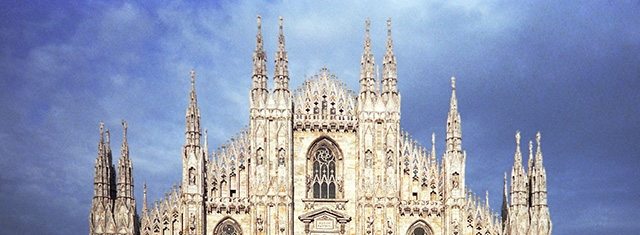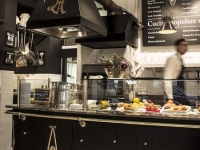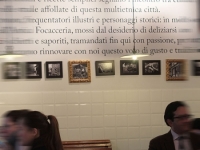Travel
MILAN-THE GREY CITY OF LOMBARDY
WONDERFUL EUROPEAN CITIES-PART I

Duomo of Milan
You could begin from the green space of Parco Sempione, which is the perfect frame of the Castello Sforzesco, symbol of the past power of Milan. Then, continue in the direction of the very known Cathedral, masterpiece of the Gothic architecture, which stands in the homonym square. The Galleria “Vittorio Emanuele II“, one of the firsts examples of art nouveau architecture in Italy, and then reach the “navigli“, which captured the curiosity of a genius like Leonardo da Vinci, who gave to this city one of his most beautiful works: “The Last Supper“, painted in the dining hall of Santa Maria delle Grazie. The San Babila quarter with a beautiful neo-romanesque church, which has become the center of Milan's fashion and luxury shops.
Cathedral of Milan:
Maybe this is the most representative monument of this city. This church, dedicated to Santa Maria Nascente, it´s the fourth in Europe for dimensions, and is the symbol of Milan. This structure is one of the principal examples of the Gothic architecture, with some peculiarities: it is the only one in which Nordic and Lombard elements finds an original harmony. The beauty of this Cathedral is completed by the major steeple, where there´s the celebrated Virgin, a golden copper statue, 4 meters high.
The Navigli:
The charming history of Navigli begins in the second half of XII century, with the construction of the first navigable stretch. The first canal, Ticinello, was opened in 1179 and was 50 kilometres long. This canal gave the impulsion to build the Major Naviglio (Naviglio Grande). The realization of these canals demanded the work of important engineers of that time, and today is still possible to appreciate the genial sluice gate conceived by Leonardo da Vinci at the end of XV century.
Once the Navigli were very popular and they were a meeting point for street markets and little shops. Nowadays this is a very fashionable area, meeting point of models, artists, university students.
The charming history of Navigli begins in the second half of XII century, with the construction of the first navigable stretch. The first canal, Ticinello, was opened in 1179 and was 50 kilometres long. This canal gave the impulsion to build the Major Naviglio (Naviglio Grande). The realization of these canals demanded the work of important engineers of that time, and today is still possible to appreciate the genial sluice gate conceived by Leonardo da Vinci at the end of XV century.
Once the Navigli were very popular and they were a meeting point for street markets and little shops. Nowadays this is a very fashionable area, meeting point of models, artists, university students.
Castello Sforzesco in Milan:
For centuries this castle has been the central point of terrible facts for the population of Milan, it was the emblem of the unbearable power of the Milan´s rulers and foreign conquerors. Finally in XX the Castle changed its role and took the one of comforting cultural place. The name of the Castle is a reference to the Italian mercenary and Duke of Milan, Francesco Sforza, that in 1450 wanted to remodel the structure.
For centuries this castle has been the central point of terrible facts for the population of Milan, it was the emblem of the unbearable power of the Milan´s rulers and foreign conquerors. Finally in XX the Castle changed its role and took the one of comforting cultural place. The name of the Castle is a reference to the Italian mercenary and Duke of Milan, Francesco Sforza, that in 1450 wanted to remodel the structure.
Nowadays this castle hosts a lot of museums: at the floor there´s the Antique art museum, at the first and second floor there´s a picture gallery and a collection of ancient furnitures, in the tower, at the first and second floor you can find the Collection of applied arts and the Musical Instruments Museum, in the basement hosts the Prehistoric Museum and the Egyptian Museum.
“The Last Supper“ by Leonardo da Vinci in Milan:
This famous, controversial and ambiguous work of Leonardo Da Vinci is kept in the dining hall of Santa Maria delle Grazie in Milan.
The Galleria Vittorio Emanuele II in Milan:
The famous Galleria Vittorio Emanuele II is considered the living room of Milan. It was built in the first half of XIX century and its style looked at the urban evolutions of the great European capitals.
This famous, controversial and ambiguous work of Leonardo Da Vinci is kept in the dining hall of Santa Maria delle Grazie in Milan.
The Galleria Vittorio Emanuele II in Milan:
The famous Galleria Vittorio Emanuele II is considered the living room of Milan. It was built in the first half of XIX century and its style looked at the urban evolutions of the great European capitals.
Shopping in Milan:
Milano and fashion are two words that come in pair, so for the shopaholic it won´t be a problem to find a place to swipe their credit card. Just think that via Montenapoleone is the heart of the fashion quadrilatero and this street of Milan is considered one of the fifteen most luxurious places of the world.
If you don´t want to spend astronomical amounts you can have a walk in Corso Vittorio Emanuele, where you can find less expensive shops.
Or you may also take a walk down CORSO BUENOS AIRES which is what I did during one of my visits to the Italian city. Its shape recalls the American type, especially Fifth Avenue in New York. The avenue stretches from Porta Venezia in Piazza Oberdan and continues straight on Corso Venezia to Piazzale Loreto.
Eating in Milan:
As for mostly of Italian cities, Milan too has its own cooking tradition. The real king of Milan´s tables is the butter, it is used in the greatest part of dishes: in the risotto, in the breaded veal cutlet and in the “panettone“. Among the first courses, the most famous is the “risotto alla milanese“, made with saffron. The traditional recipe says that beef marrow should be added as well.
After shopping in one of the 350 shops on CORSO BUENOS AIRES you might need to stop and grab a bite to eat. My eyes happened to fall on a sign indicating a " typical Sicilian" restaurant located on a side street. My being of Sicilian origins suggested I entered the ANTICA FOCACCERIA S. FRANCESCO in Via Castaldi. Could'nt have made a better choice! A friendly enviornment and fine dining at a reasonable price. Mr. Sergio Fazio will go out of his way to make you feel comfortable and he suggests the sicilian delicacies meticulously. The menu, vast and of sicilian tradition ranging from the Arancina(rice balls) to the Pasta alla Norma(pasta with egg-plants and ricotta cheese). For dessert a typical Cannoli.The staff is incredible.
Liability for this article lies with the author, who also holds the copyright. Editorial content from USPA may be quoted on other websites as long as the quote comprises no more than 5% of the entire text, is marked as such and the source is named (via hyperlink).








